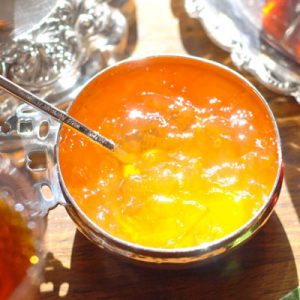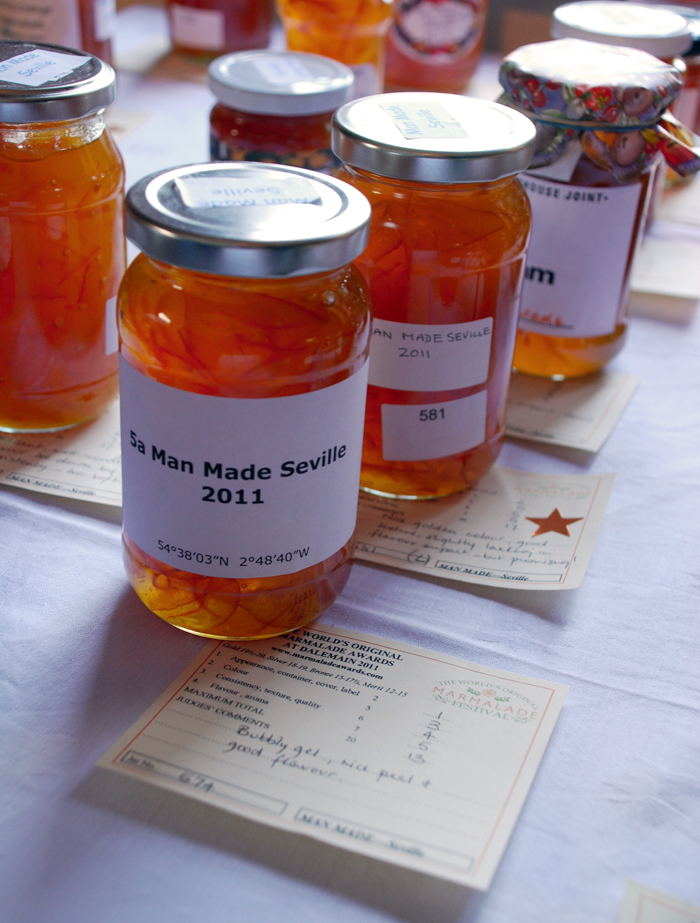 of preserves. Along with jam, jelly, chutney, pickle and curd, marmalade is a popular choice for show committees, hoping to attract entries.
of preserves. Along with jam, jelly, chutney, pickle and curd, marmalade is a popular choice for show committees, hoping to attract entries.
Standards
Since the early 1990’s I’ve noticed a decline in the number of jars and the standard of marmalade on the show bench. Jars made from tinned Seville orange pulp sometimes outweigh those made with fresh fruit. Some recipes downloaded from food websites have not made award winning marmalades, because the recipes were flawed. A lack of skills mixed with a plethora of mis-information on social media means a paucity of real marmalade. As a preserve, marmalade demands a set of heritage skills, for example slicing peel by hand.
Judges
If you are entering a competition, find out who is judging. Are they qualified to judge your jar and do they make marmalade regularly? Will they be impartial, suppress preferences and apply the same criteria to each jar they judge? How will the jars be marked? I use a mark scheme out of 20 designed by the Women’s Institute.
Mark Sheet
The Jar – 2 marks
 I prefer to judge marmalades in clear glass jars with new twist top lids. These jars and lids are designed to create airtight seals when the marmalade is poured into the jars and the lids are screwed on. When the jar is opened for judging, it should “pop” as the seal is broken.
I prefer to judge marmalades in clear glass jars with new twist top lids. These jars and lids are designed to create airtight seals when the marmalade is poured into the jars and the lids are screwed on. When the jar is opened for judging, it should “pop” as the seal is broken.
The way the jars are filled, sealed and stored affects the keeping qualities. If the jars or lids are dirty, or the jars are not full or sealed when the marmalade drops below 82C (180F) mould may develop.
Label the jar with the name of the marmalade and the date made. Jars look more attractive if they are sparkling clean. Adding frills, paper covers, ribbons and gingham should not gain extra marks, unless specified in the show schedule.
Colour and Quantity – 5 marks
I look for a bright and even coloured marmalade, with shreds of peel evenly distributed in the jar. A dark, dull colour is often caused by over-boiling the marmalade to a set. The longer the boil after the sugar has been added, the duller the colour and the fruit flavour may be compromised. Marmalades made with granulated cane ( not beet) sugar produce bright colours and good flavours. The jar should be full to within 3mm from the top. The best way to achieve this is to fill the jar to the brim. As the marmalade cools and sets, it shrinks slightly, creating a small gap and an airtight seal between the surface of the jar and the underside of the lid. Adding a waxed disc to the surface of the marmalade is unnecessary.
Quality ( Consistency and Texture) – 6 marks
Using a spoon, I test the consistency and texture of the marmalade. I look for a gelled marmalade, with a set but spreadable consistency. If the marmalade has a pouring consistency, perhaps it was not boiled enough after adding the sugar and failed to set. A stiff consistency is often due to over- boiling the marmalade. Peel risen in the jar maybe due to a poor set, the jars hot not warm before potting or the marmalade not left to stand before stirring and potting. A reliable recipe should make marmalade with the correct appearance, texture and consistency.
Flavour and Aroma – 7 marks
I always smell the marmalade hoping for an aroma of citrus and any added ingredients. devoid of taint or mustiness. Aromas are often spoilt by re-cycled lids. A marmalade with an infusion of a vinegar preserve from an old lid is unpleasant. I taste the marmalade to check the peel is tender. The flavour of the marmalade in my mouth should be balanced, not too sweet and not too fruity, but true to the ingredients in the recipe.
Choosing Winners
Towards the end of judging and particularly if the class is large, I always return to the best jars, to check that I have judged consistently and as a result been fair to all entrants. If time allows, I write a comment for each jar. Comments should be encouraging, precise and relevant. I like to explain how to correct a fault as there is nothing more dispiriting for a competitor to read “a nice jar of marmalade” as the only comment.
Practical guides to entering competitions and judging are contained in my Preserves Books


